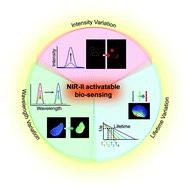当前位置:
X-MOL 学术
›
Chem. Sci.
›
论文详情
Our official English website, www.x-mol.net, welcomes your feedback! (Note: you will need to create a separate account there.)
Activatable fluorescence sensors for in vivo bio-detection in the second near-infrared window
Chemical Science ( IF 8.4 ) Pub Date : 2020-11-12 , DOI: 10.1039/d0sc04789a Mengyao Zhao 1 , Benhao Li 1 , Hongxin Zhang 1 , Fan Zhang 1
Chemical Science ( IF 8.4 ) Pub Date : 2020-11-12 , DOI: 10.1039/d0sc04789a Mengyao Zhao 1 , Benhao Li 1 , Hongxin Zhang 1 , Fan Zhang 1
Affiliation

|
Fluorescence imaging in the second near-infrared (NIR-II, 1000–1700 nm) window has exhibited advantages of high optical resolution at deeper penetration (ca. 5–20 mm) in bio-tissues owing to the reduced photon scattering, absorption and tissue autofluorescence. However, the non-responsive and “always on” sensors lack the ability of selective imaging of lesion areas, leading to the low signal-to-background ratio (SBR) and poor sensitivity during bio-detection. In contrast, activatable sensors show signal variation in fluorescence intensity, spectral wavelength and fluorescence lifetime after responding to the micro-environment stimuli, leading to the high detection sensitivity and reliability in bio-sensing. This minireview summarizes the design and detection ability of recently reported NIR-II activatable sensors. Furthermore, the challenges, opportunities and prospects of NIR-II activatable bio-sensing are also discussed.
中文翻译:

用于在第二近红外窗口中进行体内生物检测的可激活荧光传感器
第二近红外(NIR-II,1000-1700 nm)窗口中的荧光成像在更深的穿透下表现出高光学分辨率的优势(ca.由于光子散射、吸收和组织自发荧光减少,生物组织中的 5-20 毫米)。然而,无响应和“始终开启”的传感器缺乏对病变区域进行选择性成像的能力,导致生物检测过程中信噪比 (SBR) 低和灵敏度差。相比之下,可激活传感器在响应微环境刺激后显示出荧光强度、光谱波长和荧光寿命的信号变化,从而导致生物传感的高检测灵敏度和可靠性。本综述总结了最近报道的 NIR-II 可激活传感器的设计和检测能力。此外,还讨论了 NIR-II 可激活生物传感的挑战、机遇和前景。
更新日期:2020-11-22
中文翻译:

用于在第二近红外窗口中进行体内生物检测的可激活荧光传感器
第二近红外(NIR-II,1000-1700 nm)窗口中的荧光成像在更深的穿透下表现出高光学分辨率的优势(ca.由于光子散射、吸收和组织自发荧光减少,生物组织中的 5-20 毫米)。然而,无响应和“始终开启”的传感器缺乏对病变区域进行选择性成像的能力,导致生物检测过程中信噪比 (SBR) 低和灵敏度差。相比之下,可激活传感器在响应微环境刺激后显示出荧光强度、光谱波长和荧光寿命的信号变化,从而导致生物传感的高检测灵敏度和可靠性。本综述总结了最近报道的 NIR-II 可激活传感器的设计和检测能力。此外,还讨论了 NIR-II 可激活生物传感的挑战、机遇和前景。



























 京公网安备 11010802027423号
京公网安备 11010802027423号